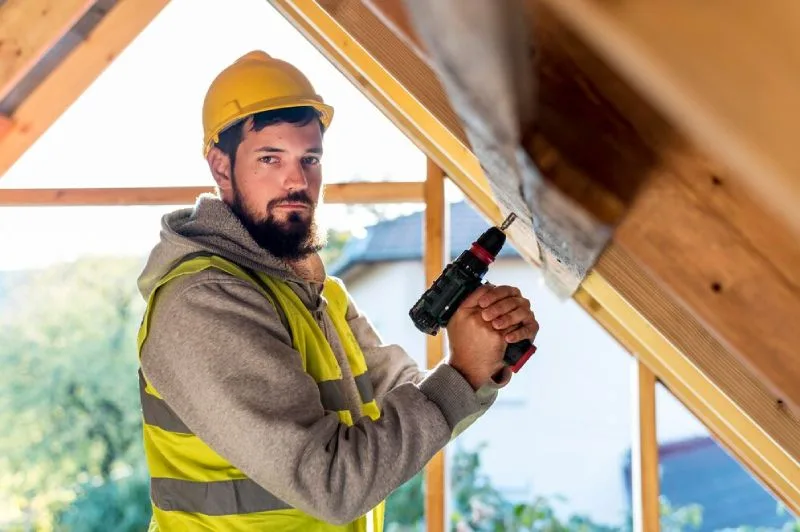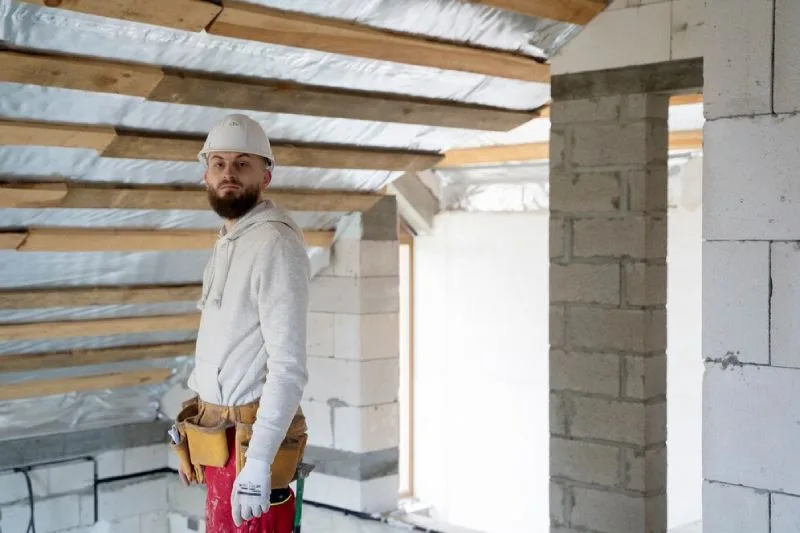Are you looking for a cozier, energy-efficient home in sunny Florida? Waterproof insulation plays a vital role in maintaining comfort and saving energy costs. With proper insulation, you can reduce your annual energy cost by almost 11%.
From keeping your space cool during hot summer months to preventing moisture-related issues, this article discusses waterproof insulation’s vital role in maintaining comfort and saving energy costs. We’ll also uncover what are the types of insulation available for homes and businesses, along with installation and maintenance tips.
What is waterproof insulation?
Waterproof insulation refers to insulation materials or products that are designed to resist the penetration of water or moisture. It is typically used in construction, particularly in areas where exposure to water or high humidity levels is a concern, such as basements, crawl spaces, exterior walls, roofs, and regions prone to heavy rainfall or flooding.
Common types of waterproof insulation materials include closed-cell spray foam, foam board insulation with a waterproof barrier, and certain types of fibreglass or mineral wool insulation designed to resist moisture. Choosing the right waterproof insulation for your specific needs and climate is essential to maintaining a dry, energy-efficient, and comfortable home.
Types of waterproof insulation materials
Waterproof insulation materials are essential for protecting your home from moisture and ensuring energy efficiency. Each type offers unique advantages, so it’s always a good idea to consult a professional HVAC contractor to determine the best solution for your property.
Closed-cell spray foam
Closed-cell spray foam insulation is a versatile and highly effective solution for improving energy efficiency and moisture control in your home. This dense foam expands upon application, creating a strong, waterproof barrier. You can use closed-cell spray foam in various areas:
- Attics — It forms an airtight seal, preventing heat loss and reducing energy bills.
- Walls — Enhance thermal performance and structural integrity while thwarting moisture intrusion.
- Crawlspaces and Basements — Protect against dampness and mold growth, ensuring a dry, comfortable environment.
Rigid foam board
Rigid foam board insulation is a standout choice for enhancing energy efficiency and comfort in your home or business. Opting for rigid foam board insulation is a smart investment in building durability, ensuring a cost-effective environment.
Here are three compelling reasons why you should consider using this versatile insulation:
- High Thermal Resistance — Rigid foam board offers impressive R-values, effectively reducing heat transfer and stabilising indoor temperatures year-round.
- Moisture Resistance — Its closed-cell structure repels water, preventing mold and mildew growth and safeguarding your property against moisture-related damage.
- Versatility — Rigid foam boards are suitable for various applications, including walls, roofs, and foundations, making them a versatile and reliable choice for residential and commercial spaces.
Waterproof fiberglass insulation
Waterproof fiberglass insulation is a top-notch solution for maintaining energy efficiency and moisture control in residential and commercial spaces. This material is a smart way to improve insulation, ensuring energy savings and a more comfortable atmosphere in various applications.
- Attic Insulation — In residential settings, waterproof fiberglass insulation is perfect for attic spaces. It effectively retains heat, keeping your home warm in winter and cool in summer, while its waterproof properties prevent moisture damage.
- Exterior Walls — It’s a valuable choice for insulating exterior walls in commercial buildings, enhancing energy efficiency, and creating a comfortable indoor environment.
- Soundproofing — In both settings, waterproof fiberglass insulation helps dampen sound, providing a quieter and more pleasant living or working space.
Cellulose insulation with waterproofing treatment
Cellulose insulation treated with a waterproofing solution is a remarkable choice for homeowners looking to bolster their property’s insulation and moisture protection. These insulation materials combine sustainability, energy efficiency and moisture resistance, delivering substantial value for your home and comfort.
- Sustainable Insulation — Cellulose insulation is an eco-friendly option, primarily made from recycled paper, contributing to a greener home and a healthier planet.
- Energy Efficiency — The insulation’s high thermal performance helps maintain stable indoor temperatures, reducing heating and cooling costs throughout the year.
- Waterproofing Treatment — The added waterproofing treatment ensures protection against moisture, preventing mold, rot, and structural damage, making it an ideal choice for damp-prone areas like basements and crawlspaces.
How waterproof insulation differs from standard insulation
Waterproof insulation stands apart from standard insulation in several key ways, making it a valuable choice for moisture-prone areas. Choosing waterproof insulation over standard insulation can significantly impact the durability and effectiveness of your insulation, ensuring a more resilient and comfortable space.
Here are four notable differences:
- Water Resistance — Waterproof insulation is specially designed to repel moisture, safeguarding against water intrusion, mold growth, and structural damage, which is not a feature of standard insulation.
- Enhanced Durability — Its construction is more robust, ensuring it maintains its insulating properties even when exposed to water, while standard insulation may deteriorate in wet conditions.
- Versatility — Waterproof insulation is suitable for a broader range of applications, including basements, crawl spaces, and exterior walls, offering reliable protection where standard insulation might fail.
- Longevity — Waterproof insulation often has a longer lifespan due to its ability to resist moisture, providing lasting insulation and comfort in your home or business.
Benefits of Waterproof Insulation
Waterproof insulation offers immense benefits for both businesses and homes. It provides superior moisture protection, preventing mold and structural damage. This translates to improved indoor air quality and reduced maintenance costs. Additionally, it enhances energy efficiency, leading to lower utility bills and a more comfortable environment.
Protection against moisture damage
Protecting your property against moisture damage is essential. Here are three key points to consider:
- Mold Growth Prevention -— Proper insulation and waterproofing solutions keep moisture at bay, preventing structural deterioration and mold growth.
- Extended Lifespan -— By safeguarding your building from water-related issues, you ensure a longer and more durable structure.
- Cost Savings —- Avoiding costly repairs and maintenance by investing in moisture protection translates to substantial long-term savings.
Improved energy efficiency
Enhancing energy efficiency is crucial for both cost savings and environmental sustainability. Here are three reasons why it matters:
- Lower Utility Bills — Improved energy efficiency means reduced energy consumption, leading to lower monthly utility costs.
- Reduced Environmental Impact — Energy-efficient practices help decrease greenhouse gas emissions, contributing to a healthier planet.
- Enhanced Comfort — An energy-efficient home or business provides more consistent temperatures and a cozier atmosphere, improving overall comfort and well-being.
Enhanced indoor air quality
Enhancing indoor air quality is essential for a healthy and comfortable living or working environment. Waterproof insulation is a smart investment that ensures lasting comfort and savings for residential and commercial spaces.
- Allergen Reduction — Improved air quality reduces allergens, leading to fewer allergies and respiratory issues.
- Health Benefits — Cleaner air promotes overall well-being, reducing the risk of illnesses related to poor indoor air quality.
- Odor Control — Enhanced ventilation and air filtration systems help eliminate unpleasant odors, ensuring a more pleasant and fresh indoor atmosphere.
Extended lifespan of the building structure
Extending the lifespan of a building structure is crucial for long-term durability and cost savings. Here are three reasons why it’s essential:
- Structural Issues Prevention — Effective waterproofing and insulation solutions protect against water damage, preventing decay and structural issues.
- Reduced Wear and Tear — Proper maintenance and energy-efficient practices ensure less wear and tear on building components, leading to a longer-lasting structure.
- Higher Property Value — A well-maintained building with an extended lifespan retains or increases its value, offering better returns on your investment.
Where Waterproof Insulation Is Needed
Waterproof insulation is a critical component in areas of your home or business that are susceptible to moisture-related issues. It’s essential in spaces like basements, crawlspaces, and attics, where water intrusion can lead to structural damage and mold growth. Exterior walls and roofs also benefit from waterproof insulation to protect against weather elements and maintain energy efficiency.
Exterior walls
When it comes to protecting your home from the elements, installing waterproof insulation on exterior walls is a wise decision. Waterproof insulation creates a sturdy barrier against rain, preventing infiltration and safeguarding your property’s structural integrity.
By keeping moisture out, waterproofing insulation helps prevent mold and mildew growth. It also enhances thermal performance, reducing heat loss or gain through the walls, resulting in lower energy bills.
Basements and crawlspaces
When it comes to your basement and crawlspace, waterproof insulation is a game-changer. It keeps these areas dry, preventing water damage and mold growth and ensuring a healthy environment. By reducing heat loss or gain, it improves energy efficiency through your property while preserving your property’s durability and longevity.
Attics and roofs
Attics and roofs are prime candidates for waterproof insulation, offering a range of benefits. These insulation materials come in various sizes and configurations, so selecting the right type is crucial to ensure complete coverage and effective moisture resistance.
The climate in your area plays a role in choosing the materials for your attics and roofs. To enhance energy efficiency, preventing heat transfer can lead to significant savings on your heating and cooling bills.
Foundation walls
Waterproof insulation for foundation walls is a smart choice for any home. The thickness of the insulation and its complete coverage on foundation walls are crucial to ensure a robust barrier. Areas with heavy rainfall or high water tables should prioritise waterproof insulation to prevent structural damage.
Selecting the right type of insulation materials is essential, with options like rigid foam or spray foam providing effective protection against water intrusion.
Around windows and doors
Waterproof insulation around windows and doors is vital for maintaining a weatherproof and energy-efficient home. Different types of materials, like foam boards, offer varying levels of protection. Proper installation ensures a tight seal, preventing air and moisture.
It is important to assess your budget to strike a balance between cost and performance, opting for insulation that meets your needs and financial constraints.
Installation of Waterproof Insulation
The installation of waterproof insulation in businesses and homes is a wise investment. It ensures moisture protection, enhances energy efficiency, and prolongs the life of your property.
Whether for residential comfort or commercial sustainability, waterproof insulation offers comprehensive benefits in safeguarding structures against the elements and maintaining a comfortable environment.
DIY vs. professional installation
When it comes to insulation installation, the DIY approach might seem tempting, but there are significant advantages to choosing professional services. While DIY projects may save on upfront costs, professional installations offer expertise, ensuring proper insulation coverage, effective moisture resistance, and compliance with local building codes.
Professionals have the right tools, experience, and access to high-quality materials, resulting in superior, long-lasting results. In the long run, opting for professional services is a wise investment in your property’s comfort, energy efficiency, and durability.
Safety precautions
Ensuring safety during waterproof insulation installation is paramount for a successful project. Here are three key precautions to take:
- Personal Protective Equipment — Always wear appropriate gear, including gloves, safety goggles, and respiratory protection, to shield against potential health hazards from insulation materials.
- Ventilation — Adequate ventilation is crucial to prevent exposure to harmful fumes or particles. Ensure proper airflow when working in confined spaces.
- Fire Safety — Keep insulation materials away from open flames and heat sources, as some types can be flammable. Use fire-resistant insulation when needed, and have fire extinguishing equipment on hand. Safety should be a top priority during any insulation project.
Proper installation techniques
Proper installation techniques are essential to ensure the effectiveness of insulation in your home or business. Here are three key factors to consider:
- Seamless Coverage — Insulation should be installed without gaps or voids, creating a continuous barrier to prevent heat transfer and moisture intrusion.
- Correct Material Selection — Choose the right type of insulation for the specific area, considering factors like moisture levels and climate.
- Professional Installation — Hiring experienced installers guarantees that the work is done correctly, complying with local building codes and ensuring long-lasting performance. Proper installation techniques are essential for optimal insulation results.
Common mistakes to avoid
DIY waterproof insulation installation can be tempting, but avoiding common mistakes is crucial for success. Here are three pitfalls to steer clear of:
- Inadequate Coverage — Failing to achieve full and even coverage can leave gaps, reducing insulation effectiveness.
- Improper Material Selection — Choosing the wrong insulation type for the location or climate can lead to inefficiency or moisture-related problems.
- Neglecting Air Sealing -— Forgetting to seal gaps and cracks before insulating can compromise the insulation’s performance. Avoid these errors for a successful DIY insulation project.
Maintenance and Care
Maintenance and care of waterproof insulation are essential to uphold its effectiveness over time. Regular inspections and necessary repairs prevent moisture infiltration, maintaining energy efficiency and preserving the insulation’s longevity. This ensures that your property remains comfortable, protected from the elements, and cost-efficient in the long run.
Addressing potential issues promptly is vital in maintaining the effectiveness of waterproof insulation. Timely intervention can prevent minor problems from escalating into costly, extensive damage.
Regular inspections can uncover issues like cracks, gaps, or water damage, enabling swift resolution. When problems are detected, don’t procrastinate. Address them immediately, whether it’s sealing cracks, fixing leaks, or replacing damaged insulation. In complex cases, consult experts who can diagnose and rectify the problem accurately, ensuring long-term insulation performance.
Here are some key points to reapplication of waterproofing treatments:
- Regularly reapply waterproofing coatings to maintain their protective qualities.
- Ensure the treated areas are clean and dry before reapplying the treatment.
- Follow manufacturer guidelines for the recommended reapplication frequency.
- Pay special attention to high-moisture areas such as basements and crawl spaces.
- Consistent reapplication ensures that your waterproof insulation continues to shield your home against moisture effectively, preserving its structural integrity and your comfort.
Comparing Costs and Return on Investment
When installing waterproof insulation, it’s crucial to compare costs and assess the return on investment. While the initial expense may be higher, the long-term benefits outweigh it.
Waterproof insulation prevents costly structural damage and promotes energy efficiency, lowering utility bills. In the end, the investment in waterproof insulation pays off in both comfort and savings.
Cost of waterproof insulation materials and installation
The cost of waterproof insulation materials and installation is a critical consideration when enhancing your property. Understanding the costs involved is essential for making an informed decision on your waterproof insulation investment.
- Material Selection — The type of insulation chosen, such as spray foam or foam board, varies in cost based on effectiveness and application.
- Property Size — The size and layout of your home or business impact the quantity of materials required and, consequently, the overall cost.
- Labor Costs — Professional installation services add to the budget, but they ensure proper application and long-term performance.
- Additional Features — Extra features like vapor barriers, sealants, or waterproof coatings may incur additional expenses depending on specific requirements.
Expected energy savings and reduced maintenance costs
Investing in waterproof insulation brings not only improved moisture resistance but also significant energy savings and reduced maintenance costs. By creating a barrier against water intrusion, this insulation type protects your property’s structure while also enhancing energy efficiency.
The reduced need for heating and cooling translates into lower utility bills, making waterproof insulation a cost-effective, long-term solution.
ROI calculations
Calculating the return on investment (ROI) for waterproof insulation installation is crucial for making informed decisions. By assessing these elements, you can gauge the substantial returns waterproof insulation offers for your property. Consider these key factors:
- Energy Savings — Estimate the reduction in utility bills due to enhanced energy efficiency.
- Maintenance Costs — Factor in savings from reduced repairs and replacements.
- Property Value — A well-insulated, moisture-resistant property often commands a higher resale value.
- Comfort and Health — Improved living conditions and air quality contribute to ROI by enhancing overall well-being.

Environmental Impact
The environmental impact of choosing waterproof insulation for homes and businesses is undeniably positive. Waterproof insulation not only enhances energy efficiency but also contributes to sustainability. By reducing energy consumption, it minimizes greenhouse gas emissions, lessening the carbon footprint.
Additionally, many waterproof insulation materials are made from recycled or sustainable resources, reducing environmental harm. This choice not only protects your property but also contributes to a greener, healthier planet, making it an eco-conscious investment.
Conclusion
Waterproof insulation stands as a reliable solution, offering a multitude of benefits, from moisture protection to energy efficiency and environmental sustainability. As homeowners, it’s crucial to recognize the value of this investment. We encourage you to explore the possibilities of waterproof insulation for your property, safeguarding your home’s durability and your family’s comfort.
For professional guidance and services, don’t hesitate to contact us today and take the first step towards a safer, more efficient, and eco-friendly living space.




